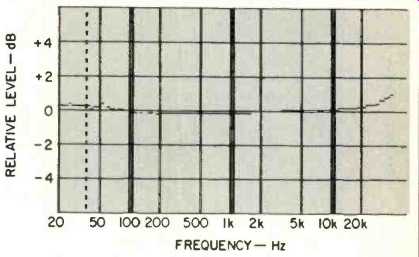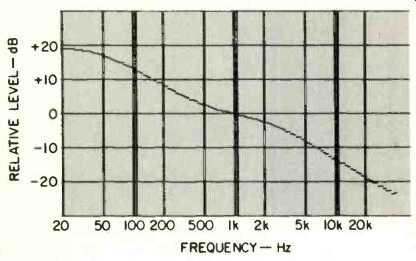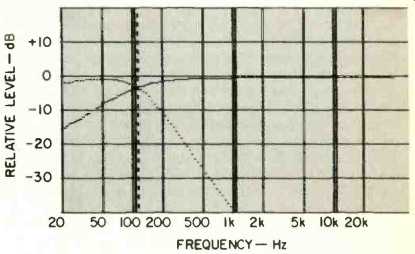
Manufacturer's Specifications
Phono Section:
Input Impedance: 50 kilohms/47 pF (adjustable internally). Gain: 32 dB at 1 kHz.
RIAA Accuracy: Within ±0.1 dB, 20 Hz to 20 kHz.
Input Sensitivity: 2.5 mV. THD: 0.001% at 0.5 V out.
SMPTE IM: 0.002% S/N: 87 dB, A weighted.
Phono Overload Level: 420 mV. Slew Rate: 100 V/µS.
Main Amplifier Section:
Rated Output: 0.5 V. Gain: 20 dB.
Frequency Response: 3.5 Hz to 2 MHz, +0,-3 dB.
Slew Rate: 110 V/µS.
S/N: 107 dB, IHF A weighted.
THD: 0.001% at 0.5 V.
SMPTE IM: 0.0015%.
Maximum Output: 16 V.
Output Impedance: 220 ohms.
General Specifications:
Subsonic Filter: -3 dB at 16 Hz, 6 dB/octave.
Subwoofer Filter: Low-pass output, -3 dB at 115 Hz, 12 dB/octave; high-pass output, -3 dB at 115 Hz, 6 dB/octave.
Maximum Tape Output: 9 V rms.
Gain:-6 dB, tape in to tape out.
Headphone Driver: 9 V rms maximum.
Input Impedance: High-level inputs, 20 kilohms.
Dimensions: 19 in. (48.26 cm) W x 23/8 in. (6.03 cm) H x 10 1/2 in. (26.67 cm) D.
Weight: 11 1/4 lbs. (5.06 kg).
Price: $699.00; optional MC phono module, $99.00.
David Stebbings, the president of KM Laboratories, appears on the cover of the brochure introducing this superb preamplifier to prospective consumers. He is quoted as saying, "I designed the SP-100 with one unwavering goal in mind: Keep the signal path as simple as is humanly possible." Indeed, the signal path in the SP-100 is about as simple and straightforward as it can get, but Stebbings hasn't ruled out the possibility that some listeners (even avowed audiophile purists) may, at one time or another, want to do some signal processing after all. Accordingly, he's left a lot of room inside the preamp's slim chassis to accommodate such optional drop-in processing boards as a rear-channel-Space Expander module, a graphic equalizer, a compressor/expander, or even an SO quadraphonic decoder module for those diehards who still own and play four-channel discs.
The elegantly styled, rack-mountable black front panel has only three rotary controls (a program selector switch, balance control and master gain control), a power on/off button and indicator light, a stereo phone jack, and a row of seven pushbutton switches. These include source/tape selection, tape 1/tape 2 selector, stereo/mono switch, low filter on/off, subwoofer on/off (about which more in a moment), processor on/off (for introducing optional modules), and a mute on/off button.
The rear panel of the SP-100 has its inputs and outputs neatly grouped in separate clusters. Gold-plated phono input jacks are provided, with the second pair intended for connection of the optional pre-preamp if a moving-coil cartridge is used. When you stop to think about it, having the MC input available as an option makes a good deal of sense, since those who are happier with MM pickups should really not be obliged to pay for a feature they may never use. Besides the tape 1, tape 2, main 1 and main 2 outputs (the latter pair being in parallel), there are a pair of outputs labeled Back for connection to a second amplifier if the user has incorporated a rear-channel reverb unit or KM's SC) decoder, and another pair of outputs identified by the letters SW, which stand for subwoofer. When the front panel SW button is depressed, a built-in electronic crossover system comes into play, feeding all signals below 115 Hz to these jacks; signals above 115 Hz are channeled to the main output jacks. Adjacent to the subwoofer output jacks is a subwoofer level control which permits the user to balance levels in a biamped system even if the associated power amp used with the subwoofer lacks its own input level control. In short, if you plan to go to the biamp route in setting up a component system, choosing the KM Labs SP 100 would be very practical, since you won't have to purchase a separate electronic crossover unit.
Although I was not provided a schematic diagram of the SP-100, I did spend some time examining its internal layout and construction. I discovered that monolithic FETs are used as input stages to the phono and main amp sections and that cascode differential amplifier configurations are used so that load impedances remain absolutely constant, regardless of what external sources are connected. The cascode configuration also permits all of the input-stage FETs to operate at optimum low-voltage, low-noise conditions, while allowing the total overall voltage to be high enough for a superb phono overload factor and high output-voltage swings. Only one capacitor is wired in series with the total signal path (used as a safety measure against possible d.c. inputs), and it is a polypropylene, 1% tolerance type, as are the capacitors found in the phono equalization circuits. Metal-film resistors are sprinkled liberally throughout the SP-100, and a toroidal power transformer is used in the power supply section. Both the volume and balance controls are thick-film, vacuum-deposited stepped attenuators. All switch contacts are silver-plated.
Measurements
It almost goes without saying that, having examined the published specifications for distortion, I saw little point in trying to confirm those readings since my lab equipment has residual distortion levels of the same order of magnitude. I was, however, able to measure and evaluate many other operating parameters. The unit tested was equipped with the optional MC module, and the inputs to this module had a sensitivity (for 0.5-V output) of 0.11 mV, exactly 20 dB lower than the 1.1-mV input sensitivity measured for the moving-magnet inputs. KM Labs has not yet adopted the standard reference levels of the new amplifier measurement standards, hence their input sensitivity figure of 2.5 mV for the MM inputs and 0.25 mV for the MC module inputs.
Phono overload measured 420 mV using the moving-magnet inputs, exactly as claimed, and 40 mV for the MC inputs. Signal-to-noise ratio for the moving-magnet phono inputs measured 84 dB, A weighted; for the moving-coil inputs (referenced to 0.5-mV input and 0.5-V output) it was just short of 70 dB. High-level input sensitivity was 46 mV for 0.5-V out, while signal-to-noise ratio for the high-level (tuner, AUX, or tape) inputs was a very high 98 dB (referred to 0.5-V in and 0.5-V out), A weighted. Figure 1 is a plot of RIAA equalization accuracy, from 20 Hz to beyond 20 kHz, in which an inverse RIAA signal is applied to the phono inputs. If RIAA equalization were perfect, the plot (which was made using an amplitude scale of 2 dB per division) would be a straight horizontal line. In fact, a deviation of +0.3 dB was observed at 37 Hz. The slight rise it response at the high-frequency extreme actually occurs beyond 20 kHz, which is represented by the right-most vertical line in this video printout. The more familiar RIAA playback curve, plotted on a scale of 10 dB per division from 20 Hz to above 20 kHz and using a constant amplitude input rather than the inverse RIAA signal of Fig. 1, is shown in Fig. 2.
Figure 3 is a plot of the response obtained when the front panel subwoofer switch is depressed. Main output response rolls off at the low end at a rate of 6 dB per octave, while the output from the SW jacks provides ultra-bass frequencies only and crosses over at 115 Hz, where each of the two response curves is at approximately the "half power" or-3 dB point.

Fig. 1--Deviation from RIAA equalization using input through an inverse
RIAA network.

Fig. 2--RIAA playback curve with constant amplitude input.

Fig. 3--When used as an electronic crossover for subwoofers, the SP-100
crosses over at 115 Hz.
Use and Listening Tests
I used the SP-100 preamplifier with both moving-coil and moving-magnet cartridges. Results were excellent with the moving-magnet cartridge, but residual noise was a bit higher than I would have liked when using the moving-coil cartridge. If you plan to use an MC pickup with this preamp, try to choose one that has relatively high output so as to get the signal up and away from this residual noise and hum "floor." You needn't fear overloading the pre-preamp module since, as I noted, 40 mV at 1 kHz is a long, long, way from 0.11 mV-the nominal input sensitivity of this module.
All switches and controls operated smoothly without inducing pops or any other form of electrically induced noise.
The phono input (even the high-gain MC input) was relatively immune to radio frequency rectification--a problem encountered with many other high-gain preamp circuits. The ultra-wide bandwidth of this preamp may well be responsible, at least in part, for the open musical quality I perceived when listening to some of my favorite program material. I was told that KM Labs actually measures response and phase shift through the preamp using video test signals and video test equipment. I didn't go quite that far in my tests, but feel fairly certain that any preamp that has flat response and minimum phase shift to beyond 1 MHz, as this one does, is not about to have slew-induced distortion problems, audible coloration, or imaging problems. The wide bandwidth, incidentally, makes this preamp's resistance to r.f. interference all the more commendable.
One word of caution. If you buy this preamp and use it with a moving-magnet cartridge, make certain that you read about how to add any needed picofarads of capacitance to the cartridge load. Terminal strips inside the unit were made specifically for such customizing and load matching, and unless you have a fair amount of capacitance in your turntable cables, chances are you'll need to add a bit of "C" here, since the supplied value is only 47 pF. I feel that the SP-100 has been carefully designed to do the job that its makers intended it for-conveniently controlling and amplifying a variety of input signals with a minimum amount of tampering with the nature and content of those signals. The degree to which that goal has been achieved justifies the price of the KM Labs SP-100 preamplifier.
-Leonard Feldman
(Source: Audio magazine, May 1982)
Also see:
Klyne SK-5A Preamp (Equip. Profile; Jan. 1988)
Kinergetics KPA-1 Preamp (Equip. Profile; Aug. 1986)
Kensonic Accuphase C-200 Control Amplifier, P-300 Power Amp (Mar. 1975)
= = = =